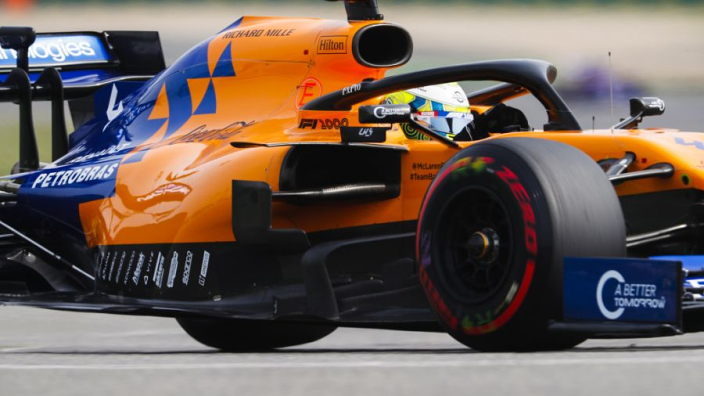M840TR wrote: ↑19 Apr 2019, 16:44
trinidefender wrote: ↑19 Apr 2019, 15:23
M840TR wrote: ↑19 Apr 2019, 12:34
Carlos on performance in China:
Despite being discussed that the car isn't good in low speed corners but decent in high speed ones, my observation of the case being on the contrary has been confirmed. This is probably just down to low-drag philosophy (spoon RW) and bodes well for the rest of the season as it means they can strap on more wing to achieve the desired DF levels on tracks like Monaco and still be competitive.
https://www.formula1.com/en/latest/arti ... j96nL.html
Your quote does nothing to refute what was understood from before. Long corners rely heavily on front downforce to keep the car turning on the large sweeping corners. The rear tyres are on more lateral loads and less longditudinal loads on long corners as drivers generally keep acceleration and braking to a minimum on long rounded corners with the main acceleration and braking points being before and at the end of the corner. This makes the fronts have a higher overall loading which is why those corners are known as front limited.
Good braking action and traction out of corners relies on good rear downforce. Rear downforce gives good stability under braking reducing the chance of locking up and traction on the rear tyres to accelerate out of corners. Short "point and squirt" corners rely heavily on the rear tyres, hence making them known as rear limited, due to both lateral and longditudinal loads going through the rear tyres.
This is partially true. High-speed corners do induce a lot of force on the fronts but the rear end plays a roll as well. The car needs to be planted on both ends actually. For initial and consistent mid corner change of direction you need the front. But without significant rear DF the car would be slow or just spin out of control. This could be observed on the Mcl33. It had no substantial front DF issues yet was still slow relative to competition in high speed corners such as Spa's Pouhon due to a well documented diffuser stall.
For a less specific example, let's look at Sf71h's varying rear wings across two tracks.
Here's Canada which is dominated by low speed "point & squirt" corners.
http://f1.imgci.com/PICTURES/CMS/500/562.jpg
A view of the shallow rear wing on the car at last year's gp.
https://i.imgur.com/jqBVSTI.jpg
Here's Shanghai which is rife with mid to high speed corners
https://sundarf1.files.wordpress.com/20 ... anghai.png
A view of the higher AoA rear wing with t-wing on the same car last year
https://static.formula1.ferrari.com/img ... 617b9e.jpg
This clearly indicates that rear end traction matters in mid to high speed corners. I realize that even in slow corners it does but at such speeds aero doesn't have as big an impact as mechanical grip.
I never said rear downforce and traction don't matter in long corners. I was simply explaining why long corners tend to favour stronger front downforce cars and short corners tend to favour strong rear downforce cars. This is as a very general rule, obviously there will be large variation from car to car, track to track, individual corner to corner and driving style to driving style.
It seems that you're trying to contradict me for contradictings sake. Your one example is just that. It's one car on two tracks using a driver who very much relies on the rear stability of his car to be fast. Part of the reason for the difference could be a variety of factors but not limited to:
1. Canada has lots of straights and teams regularly trim downforce at Canada for performance on the straights.
2. Overall balance of the car. You can't use too much wing on either end otherwise you upset the overall balance of the car.
3. As stated the driving style of the driver, Seb is a very much rear biased driver who relies on a very stable rear end to know how hard he can push the car. He seems to like to push the car to its understeering limit. This usually biases his setup to be rear biased.
Lastly, the point I was making was that on long corners with less acceleration/braking through the corner, there is less longditudinal load going through the rear tyres. This means that the rears only have the lateral loads to deal with. Ergo, the fronts get loaded higher. That's all I was saying.
Back to the topic of the MCL34. To me it seems that McLaren is using the lower downforce rear wing to balance the car compared to lack of front downforce, not particularly to go for a low drag concept. Last years car was draggy however I'm fairly certain that it's not for the reason that many think. It probably has to do with the fact that McLaren were almost always running maximum rear downforce, and hence drag, settings to try to compensate for its floor instability issues. Always running the biggest rear wing possible will increase your drag a lot contributing to the slow straight line speed.
One thing I do agree with is that the current lower downforce rear wing does bode well for the rest of the season. Assuming that McLaren can add front downforce throughout the season then it should be easy to increase rear downforce with a larger rear wing to maintain car balance. Following that, top speeds will probably come down and I'm going to guess that the car will lose its title as one of the quickest straightaway cars. Trading straightaway speeds for cornering speeds, braking and traction out of corners, the latter two of the three already being quite good.







